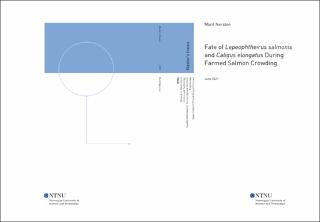| dc.description.abstract | Økt reproduksjon og spredning av Lepeophtheirus salmonis og Caligus elongatus hindrer videre vekst i oppdrettsnæringen og truer den naturlige bestanden av villaks. Trenging vil si å øke tettheten av fisken og er en viktig del av både avlusning og behandling av oppdrettslaks. I forbindelse med trengingen mistenker både marinbiologier og oppdrettsnæringen at lusa hopper/skubbes av fisken og dermed unngår avlusning og sprer seg videre i vannmassene til annen oppdrettslaks og villaks. Denne studien har derfor til hensikt å kartlegge Lepeophtheirus salmonis og Caligus elongatus under trenging av oppdrettslaks.
Prøver av atlantisk laks (Salmo salar) ble tatt før trenging og under trenging på tre ulike oppdrettslokasjon på Helgelandskysten, høsten 2020. Data for lusetall før trenging er hentet fra de ukentlige, obligatoriske lusetellingene som ble gjort av lokale røktere. Gjennomsnittlig antall fastsittende L. salmonis, bevegelige L. salmonis, voksen hunnlus L. salmonis og C. elongatus per fisk ble registrert i prøvene før trenging. Laksen ble delt inn i fire soner og antallet av de ulike stadiene av L. salmonis og antallet C. elongatus ble registrert for hver sone under trenging.
Trengeoperasjonene påvirket ikke gjennomsnittlig antall fastsittende og bevegelige L. salmonis, men antall L. salmonis voksen hunnlus og C. elongatus var i snitt signifikant høyere under trenging. Mulige forklaringer er at lusa fester seg til fisken under trenging, at lusa utvikler seg til andre stadier og/eller naturlige variasjoner i lusepopulasjonen. Endringen i gjennomsnittlig antall lus mellom før trenging og under trenging for fastsittende og bevegelige L. salmonis og C. elongatus viste en signifikant positiv korrelasjon til fiskestørrelse. L. salmonis voksen hunnlus og fiskestørrelse hadde ingen signifikant korrelasjon. Korrelasjonen kan være påvirket
av lokasjonsspesfikke faktorer som temperatur og antall dager mellom prøvetakingene samt
hvor lenge fisken har vært eksponert for sjøvann. Antall og plassering av L. salmonis og C. elongatus var ikke signifikant forskjellig i de ulike antall trengingene og i de ulike trengetypene, avkastnot og kulerekke. Måten studien er gjennomført på gir likevel ikke informasjon om lusa hopper/skubbes av fisken og deretter hopper på igjen under trengingen. Det ble funnet 0,28% L. salmonis voksen hunnlus på vertens hode (sone A) under trenging. | |
| dc.description.abstract | The spread and propagation of sea lice, including Lepeophtheirus salmonis and Caligus elongatus, have been a particular economic and ecological problem, jeopardizing the wild salmon population as well as the farmed salmon production. Crowding, increasing the fish density, is an important part of salmon handling and delousing management. Both marine biologists and fish-farmers question how stress response and mechanical impact from crowding affect lice detachment, eluding lice from delousing and spreading into free water masses. Therefore, it is of interest to investigate the fate of Lepeophtheirus salmonis and Caligus elongatus during farmed salmon crowding.
Atlantic salmon (Salmo salar ) were sampled during a pre-crowding situation and during crowding at three fish farm locations in Northern Norway, October 2020. The pre-crowding situation registrations were done by the locations, as part of obligatory, weekly lice countings. The mean number of sessile L. salmonis, mobile L. salmonis, adult female L. salmonis and C. elongatus per fish for each net pen was registered in the pre-crowding situation. The salmon body was split into four zones, and the numbers of the different stages of L. salmonis and the numbers of C. elongatus, were registered for each body zone during the crowding registration.
The crowding operations did not affect the mean numbers of sessile and mobile L. salmonis, but the mean numbers of adult female L. salmonis and C. elongatus were significantly higher during crowding. This increase might be explained by adult female L. salmonis and C. elongatus attaching to the fish during crowding, development to other stages and/or natural variations in the lice distribution. The change from pre-crowding situation to during crowding in the mean number of sessile L. salmonis, mobile L. salmonis and C. elongatus per fish, showed a significant positive correlation to fish size. Adult female L. salmonis and fish size was not significantly correlated. The correlations might be influenced by location-specific factors e.g. temperature and number of days between the samples in addition to the fish’s exposure time in the seawater.
Neither the number nor the placement of L. salmonis and C. elongatus were significantly different for the different numbers of crowding operations or the different crowding methods - swipe net and ball line. However, with the current study design, it is not known whether the lice stay on the host, or detach and reattach during the crowding. 0.28% of adult female L. salmonis were observed on the host’s head (zone A) during crowding. | |
